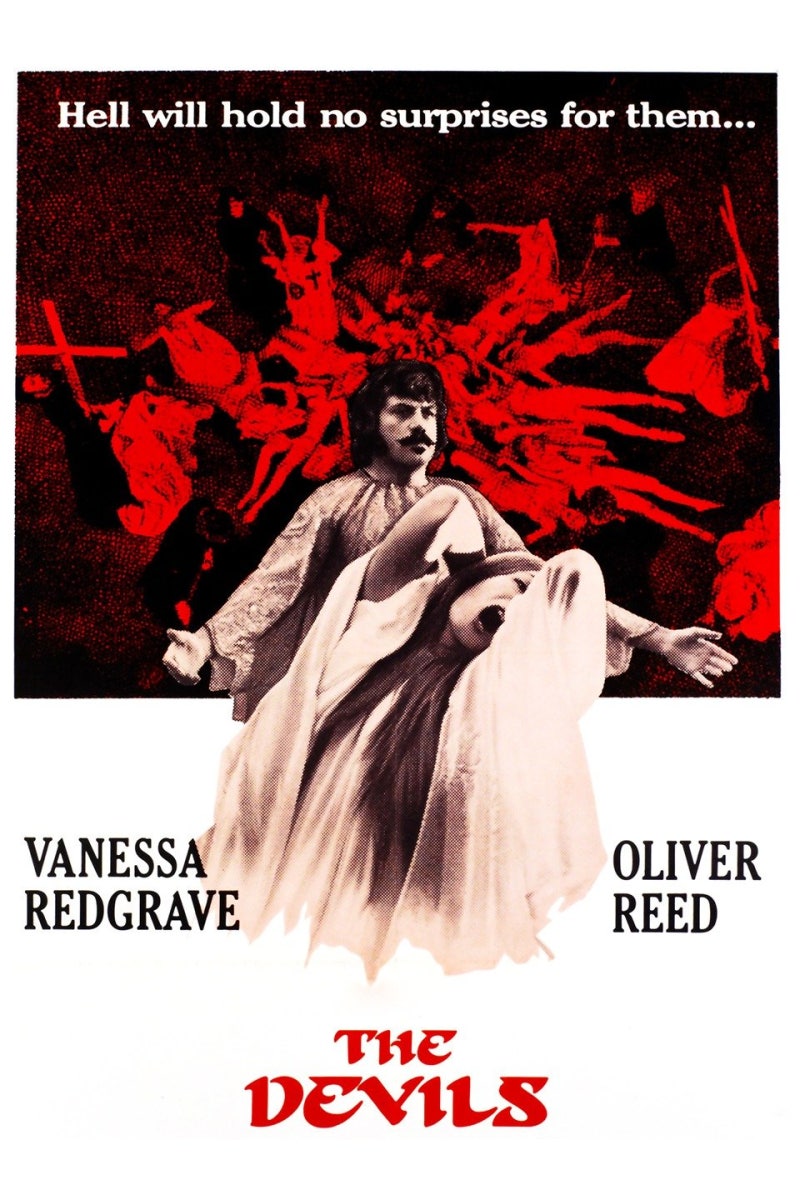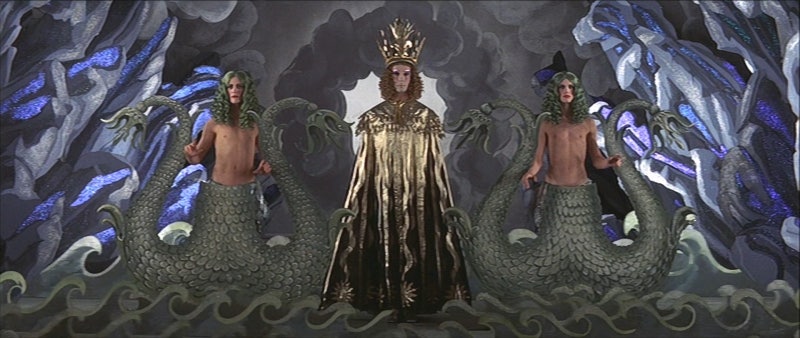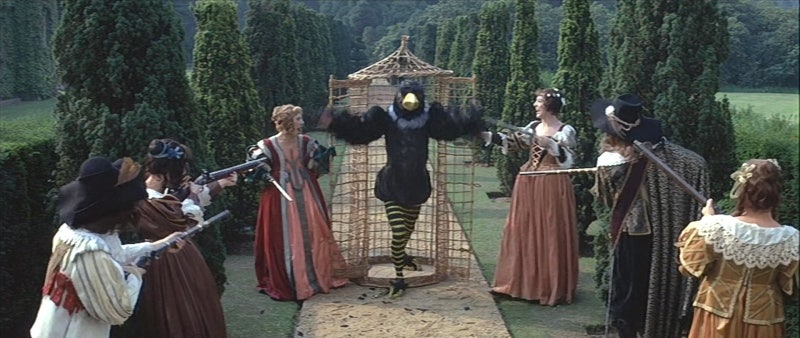프랑스 절대왕정을 확립한 리슐리외 추기경이 저지른 마녀재판, Urbain Grandier 사건 (1634); 올더스 헉슬리의 소설 The Devils of Loudun (1952)와 켄 러셀 감독의 악령들 (1971)이 이 사건에 모티브를 두고 있다
https://en.wikipedia.org/wiki/Urbain_Grandier
Urbain Grandier (1590 – 18 August 1634) was a French Catholic priest who was burned at the stake after being convicted of witchcraft, following the events of the so-called "Loudun possessions". Most modern commentators have concluded that Grandier was the victim of a politically motivated persecution led by the powerful Cardinal Richelieu.
The circumstances of Father Grandier's trial and execution have attracted the attention of writers Alexandre Dumas père, Eyvind Johnson, Aldous Huxley and the playwright John Whiting, filmmaker Ken Russell, composers like Krzysztof Penderecki and Peter Maxwell Davies, as well as historian Jules Michelet and various scholars of European witchcraft.
Life[edit]

Grandier attended the Jesuit college of La Madeleine in Bordeaux. His uncle was a priest who held some influence with the Jesuits there. They held the right to appoint the parish priest for the Church of Saint-Pierre-du-Marche in Loudun, and in 1617 chose Grandier. They also had the right to name a canon to the collegiate Church of Sainte Croix, also in Loudun, and Grandier was appointed to that as well. Thus, as the eldest son, he was able to support his widowed mother and siblings. That he should receive both valuable positions over a local candidate caused some resentment.[1] Both benefices were in the Diocese of Poitiers.
Sometime around 1629 or 1630, Philippa Trincant, daughter of Louis Trincant, the king's prosecutor and a friend of Grandier, gave birth to a son. It was widely suspected that Grandier was the father.[1] He was also believed to have had intimate relations with a number of women.[2]
Allegations of sorcery[edit]
In 1632, a group of nuns from the local Ursuline convent accused him of having bewitched them, sending the demon Asmodai, among others, to commit evil and impudent acts with them. Aldous Huxley, in his non-fiction novel, The Devils of Loudun, argued that the accusations began after Grandier refused to become spiritual director of the convent, unaware that the Mother Superior, Jeanne des Anges, had become obsessed with him after having seen him from afar and heard of his sexual exploits. According to Huxley, Mother Jeanne, enraged by his rejection, instead invited Canon Jean Mignon, an enemy of Grandier, to become the director. Jeanne then accused Grandier of using black magic to seduce her. The other nuns gradually began to make similar accusations. However, Monsieur des Niau, Counsellor at la Flèche, said that Grandier applied for the position, but that it was instead awarded to Canon Jean Mignon,[2] a nephew of Monsieur Trincant.[1]
The Archbishop of Bordeaux intervened and ordered the nuns sequestrated, upon which the instances of possession seemed to have stopped.[3]
Richelieu[edit]

Grandier had gained the enmity of the powerful Cardinal Richelieu, the chief minister of France. In its continuing efforts to consolidate and centralize power, the Crown had ordered the walls around Loudun to be demolished. The populace were of two minds concerning this, whether to keep the wall or rely on the central government for protection. Grandier supported those who wished to retain the walls.[4] In addition, not only had Grandier written a book attacking the discipline of clerical celibacy,[5] he had also penned a scathing satire on the cardinal.
Around the time of the nuns' accusations, M. Jean de Laubardemont, a relative of the Mother Superior of the convent of Loudun,[citation needed] was sent to demolish the town tower. He was prevented from doing so by the town militia, and upon returning to Paris reported on the state of affairs in Loudun including the recent disturbance at the Ursuline convent. In November 1633, Laubardemont was commissioned to investigate the matter. Grandier was arrested and confined to the prison at Angers. Laubardemont returned to Paris, where letters in support of Grandier from the Bailly of Loudun to the Procurator-General of the Parliament, stating that the possession was an "imposture" were intercepted.[2]
Trial[edit]
Laubardemont returned to Loudun with a Decree of the Council, dated 31 May 1634, confirming all his powers and prohibiting Parlement and all other judges from interfering in the matter, and forbidding all parties concerned from appealing, under penalty of a fine of five hundred livres. Grandier, who had been held at the prison of Angers was returned to Loudun. Both the examination of witnesses and the exorcisms of the Ursulines continued. After Grandier had been tortured,[citation needed] documents were introduced purportedly signed by him and several demons as evidence that he had made a diabolical pact. It is not clear whether Grandier wrote or signed the pacts under duress, or whether they were forged.
Grandier was found guilty and sentenced to death. The judges who condemned Grandier ordered that he be put to the "extraordinary question", a form of torture which was usually, but not immediately, fatal, and was therefore administered to only those victims who were to be executed soon afterwards. In addition, Grandier was subjected to a form of the Spanish boot,[citation needed] an iron vise filled with spikes, that was brought to red heat and then applied to the calves and ankles to shatter the bones. Despite torture, Grandier never confessed to witchcraft. He was then burned alive at the stake.
Many theories exist as to the cause of the Loudun "possessions". One of the most likely explanations is that the whole affair was orchestrated by Richelieu.[citation needed] Huxley in his book The Devils of Loudun (1952) and in the Ken Russell film version of the Huxley book (1971) alleged that the initial accusations against Grandier by the nuns of the convent of Loudun were part of a case of collective hysteria.
Augustin Calmet, among others, compared this case to the pretended possession of Martha Broissier (1578), which received a great deal of circulation at the time. This criticism was in part due to the fact that the circumstances revolving the incidents and the examinations of possession in question show more indications of pretended possessions than that of more dominantly legitimate cases, such as the possession of Mademoiselle Elizabeth de Ranfaing (1621).[6] In his Treatise, it is stated that the causes of the injustice committed at Loudun were a mixture of political ambition, the need for attention, and a basic desire to dispose of political opponents. The Loudun affair took place in the reign of Louis XIII; Cardinal Richelieu is accused of having caused this tragedy, in order to ruin Grandier, the Curé of Loudun, for having written a cutting satire against him.[7]
Diabolical pact[edit]

One of the documents introduced as evidence during Grandier's second trial is a diabolical pact written in Latin and apparently signed by Grandier. Another, which looks illegible, is written backwards, in Latin with scribal abbreviation, and has since been published and translated in a number of books on witchcraft. This document also carries many strange symbols, and was signed by several demons including Satan himself.[8] Deciphered and translated to English, it reads:
Artistic depictions[edit]
An 18th-century book written by historian Nicholas Aubin contains his findings on the Devils of Loudun. The book is titled, "The Cheats and Illusions of Romish Priests and Exorcists Discovered in the History of the Devils of Loudun."[9]
Grandier's trials were the subject of two treatments by Alexandre Dumas, père: an entry in volume four of his Crimes Célèbres (1840) and a novel, Urbain Grandier (1850).
The French historian Jules Michelet discussed Grandier in a chapter of La Sorcière (1862).
The Swedish author Eyvind Johnson based his 1949 novel Drömmar om rosor och eld on Grandier and the Loudun possessions.[10]
The same subject was revisited in the book-length essay The Devils of Loudun, by Aldous Huxley, published in 1952. Huxley's book was adapted for the stage in 1961 by John Whiting (commissioned by the Royal Shakespeare Company). The play was adapted for the movie screen by Ken Russell in 1971 (as The Devils). The novel was also adapted for the opera stage in 1969 by Krzysztof Penderecki (as Die Teufel von Loudun). It was also an inspiration for Matka Joanna od Aniołów (Mother Joan of the Angels) – a film by Jerzy Kawalerowicz after the story ("Matka od Aniołów|Mother Joan of the Angels") by Jarosław Iwaszkiewicz.
Grandier is the subject of "Grandier's Funeral Pyre", a song by Elvenking off the album The Pagan Manifesto (2014).
Grandier is also the subject of the song "Devils" by the pagan rock band Inkubus Sukkubus from their 1993 album Wytches.
Florida death metal band Morbid Angel used Grandier's life as one of the main themes for their album Covenant.
The Loudun possessions and Grandier's trial are the subject of Les brasiers ne s'éteignent jamais ("The Braziers Never Go Out") by Michel Gaudo, an adventure module for the French horror RPG Malefices. Learning about the historical case helps the investigators solve the mystery.
Grandier is portrayed by Oliver Reed in the 1971 Ken Russell film The Devils.
https://m.blog.naver.com/jemma4237/221719466870
The Devils
악령들. 원제, 악령들.
● 감독 : 켄 러셀 (Ken Russell)
● 장르 : 공포 / 드라마
● 국가 : 영국
● 러닝타임 : 111분
● 등급 : [국내] 청소년 관람불가 [해외] R
영국의 소설가 올더스 헉슬리(Aldous Huxley)가 출간한, 마녀사냥으로 인해 화형당한 프랑스의 가톨릭 신부 그랑디에(Urbain Grandier, 1590-1634.8.18)의 역사적 사실을 담은 소설 <루덩의 악마들(The Devils of Loudun)>을 각색하여 만든 영화이다.
충격적·선정적인 소재를 작품에 사용해여 비평가들로부터 찬사와 비난을 동시에 받는 켄 러셀(Ken Russell) 감독의 작품으로 <악령들(The Devils)> 역시 폭력과 선정성, 종교적인 소재를 다루고 있었기 때문에 많은 비난을 받는 것은 물론 여러 나라에서 상영이 금지되기도 하였다.
데릭 저먼(Derek Jarman)이 미술 감독으로 참여해 광적이고 기이한 분위기의 세트를 완벽하게 재현해 냈다. 가장 고귀하고 도덕적으로 청렴해야 할 수녀원은 퇴폐와 문란, 폭력으로 가득하고, 신에 대한 숭고한 사랑마저 성적으로 타락해버린다. 러셀 감독 특유의 풍자와 적나라한 묘사는 언제나처럼 보는 이를 불편하게 만들지만, 어느 영화보다 논쟁적이고 도발적이다.
이 영화는 1972년, 미국 내셔널 보드 오브 리뷰에서 최우수 감독상 수상하였다.
~ SYNOPSIS ~
리슐리에 추기경과 그의 추종자들은 권력 장악을 위해 그랑디에 신부를 축출하려고 음모를 꾸민다. 그들은 악마에 홀린 한 수녀를 끌어들이는데, 그녀는 그랑디에 신부에 대한 성적인 강박관념에 사로잡혀 있다. 광적인 마녀 사냥은 점점 극단적으로 변하고 인간의 악마적인 본성이 적나라하게 드러난다.



















































Comments
Post a Comment